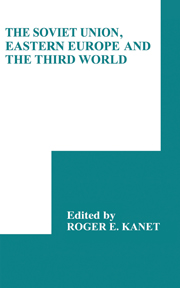Book contents
- Frontmatter
- Contents
- List of figures
- List of tables
- List of contributors
- Foreword by R.C. Elwood
- Preface by Roger E. Kanet
- PART 1 THE THIRD WORLD IN SOVIET FOREIGN POLICY
- PART 2 CMEA ECONOMIC INVOLVEMENT IN THE THIRD WORLD
- 6 Soviet economic policy in the Third World
- 7 Eastern Europe and the Third World: Economic interactions and policies
- 8 The non-European members of the CMEA: a model for developing countries?
- PART 3 THE SOVIET UNION IN THE MIDDLE EAST AND SOUTH ASIA
- Index
- Publications from the Third World Congress for Soviet and East European Studies, Washington, 1985
7 - Eastern Europe and the Third World: Economic interactions and policies
from PART 2 - CMEA ECONOMIC INVOLVEMENT IN THE THIRD WORLD
Published online by Cambridge University Press: 06 July 2010
- Frontmatter
- Contents
- List of figures
- List of tables
- List of contributors
- Foreword by R.C. Elwood
- Preface by Roger E. Kanet
- PART 1 THE THIRD WORLD IN SOVIET FOREIGN POLICY
- PART 2 CMEA ECONOMIC INVOLVEMENT IN THE THIRD WORLD
- 6 Soviet economic policy in the Third World
- 7 Eastern Europe and the Third World: Economic interactions and policies
- 8 The non-European members of the CMEA: a model for developing countries?
- PART 3 THE SOVIET UNION IN THE MIDDLE EAST AND SOUTH ASIA
- Index
- Publications from the Third World Congress for Soviet and East European Studies, Washington, 1985
Summary
The interests of the East European countries in the Third World are usually much less discussed than those of the Soviet Union. It is assumed that East European relations with the developing countries are more or less aligned with Soviet policy, only with less important stakes. Very few specific studies have been devoted in the West to this topic. This is paralleled by a disproportion in the amount of literature published in the Soviet Union and in the East European countries. There is nothing comparable in the latter to the number of general and specialized Soviet institutes dealing with the Third World. To our knowledge only Hungary has a Center for Development Studies attached to the Institute for World Economics of the Academy of Sciences. In the other East European countries the institutions dealing with the developing countries are mostly interested in civilization, geography and language studies, and only marginally in economic problems.
This paper aims to present the main conclusions of a group research project on East–South relations. An earlier article from this project by Marie Lavigne has stressed the major differences between Soviet and Eastern European patterns of trade and cooperation in the Third World. Here we would like to elaborate on a particular aspect of this pattern – the gains in hard currency derived from those relations.
The expansion of trade between Eastern Europe and the Third World has, in general, been greater than the growth of the total trade of the six smaller CMEA members.
- Type
- Chapter
- Information
- The Soviet Union, Eastern Europe and the Third World , pp. 141 - 162Publisher: Cambridge University PressPrint publication year: 1988



